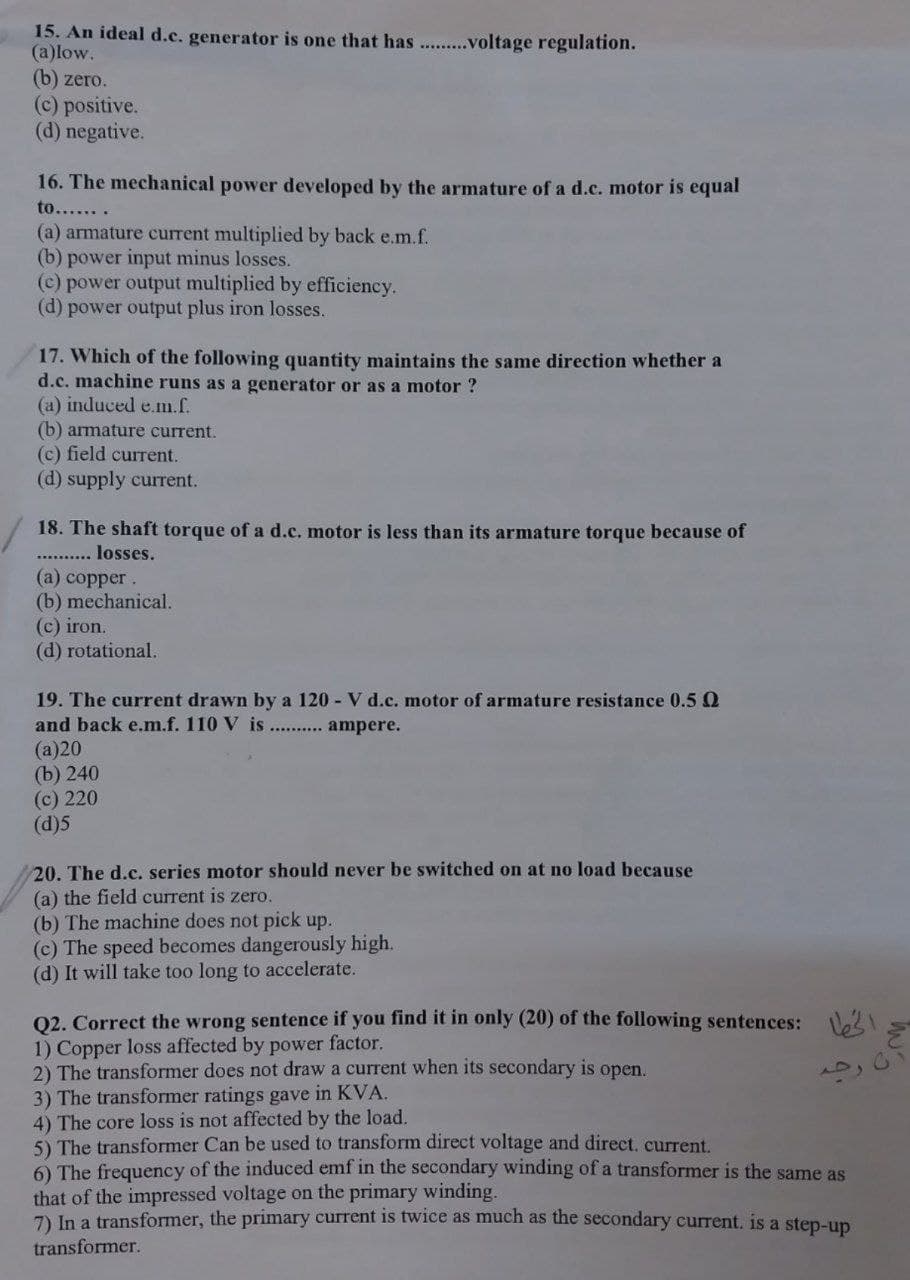15. An ideal d.c. generator is one that has ...........voltage regulation. (a)low. (b) zero. (c) positive. (d) negative.
15. An ideal d.c. generator is one that has ...........voltage regulation. (a)low. (b) zero. (c) positive. (d) negative.
Introductory Circuit Analysis (13th Edition)
13th Edition
ISBN:9780133923605
Author:Robert L. Boylestad
Publisher:Robert L. Boylestad
Chapter1: Introduction
Section: Chapter Questions
Problem 1P: Visit your local library (at school or home) and describe the extent to which it provides literature...
Related questions
Question

Transcribed Image Text:15. An ideal d.c. generator is one that has ...........voltage regulation.
(a)low.
(b) zero.
(c) positive.
(d) negative.
16. The mechanical power developed by the armature of a d.c. motor is equal
to.......
(a) armature current multiplied by back e.m.f.
(b) power input minus losses.
(c) power output multiplied by efficiency.
(d) power output plus iron losses.
17. Which of the following quantity maintains the same direction whether a
d.c. machine runs as a generator or as a motor ?
(a) induced e.m.f.
(b) armature current.
(c) field current.
(d) supply current.
18. The shaft torque of a d.c. motor is less than its armature torque because of
losses.
(a) copper.
(b) mechanical.
(c) iron.
(d) rotational.
19. The current drawn by a 120 - V d.c. motor of armature resistance 0.5
and back e.m.f. 110 V is.......... ampere.
(a)20
(b) 240
(c) 220
(d)5
20. The d.c. series motor should never be switched on at no load because
(a) the field current is zero.
(b) The machine does not pick up.
(c) The speed becomes dangerously high.
(d) It will take too long to accelerate.
Q2. Correct the wrong sentence if you find it in only (20) of the following sentences:
1) Copper loss affected by power factor.
2) The transformer does not draw a current when its secondary is open.
3) The transformer ratings gave in KVA.
4) The core loss is not affected by the load.
5) The transformer Can be used to transform direct voltage and direct. current.
6) The frequency of the induced emf in the secondary winding of a transformer is the same as
that of the impressed voltage on the primary winding.
7) In a transformer, the primary current is twice as much as the secondary current. is a step-up
transformer.
Expert Solution
This question has been solved!
Explore an expertly crafted, step-by-step solution for a thorough understanding of key concepts.
Step by step
Solved in 2 steps with 1 images

Knowledge Booster
Learn more about
Need a deep-dive on the concept behind this application? Look no further. Learn more about this topic, electrical-engineering and related others by exploring similar questions and additional content below.Recommended textbooks for you

Introductory Circuit Analysis (13th Edition)
Electrical Engineering
ISBN:
9780133923605
Author:
Robert L. Boylestad
Publisher:
PEARSON

Delmar's Standard Textbook Of Electricity
Electrical Engineering
ISBN:
9781337900348
Author:
Stephen L. Herman
Publisher:
Cengage Learning

Programmable Logic Controllers
Electrical Engineering
ISBN:
9780073373843
Author:
Frank D. Petruzella
Publisher:
McGraw-Hill Education

Introductory Circuit Analysis (13th Edition)
Electrical Engineering
ISBN:
9780133923605
Author:
Robert L. Boylestad
Publisher:
PEARSON

Delmar's Standard Textbook Of Electricity
Electrical Engineering
ISBN:
9781337900348
Author:
Stephen L. Herman
Publisher:
Cengage Learning

Programmable Logic Controllers
Electrical Engineering
ISBN:
9780073373843
Author:
Frank D. Petruzella
Publisher:
McGraw-Hill Education

Fundamentals of Electric Circuits
Electrical Engineering
ISBN:
9780078028229
Author:
Charles K Alexander, Matthew Sadiku
Publisher:
McGraw-Hill Education

Electric Circuits. (11th Edition)
Electrical Engineering
ISBN:
9780134746968
Author:
James W. Nilsson, Susan Riedel
Publisher:
PEARSON

Engineering Electromagnetics
Electrical Engineering
ISBN:
9780078028151
Author:
Hayt, William H. (william Hart), Jr, BUCK, John A.
Publisher:
Mcgraw-hill Education,